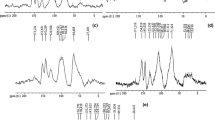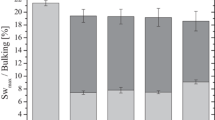Abstract
Fixation of boric acid as a low toxicity wood preservative to decrease markedly its leachability was undertaken. Preservative systems based on the cross-linking and hardening of condensed tannins by hexamine, where boric acid is complexed onto the network, were found to markedly slow down the leaching of boron. They significantly enhanced wood durability before and after leaching once tested towards basidiomycetes according to the guidelines of EN 113. A particularly virulent fungal species was used for the tests. Further immersion of the wood so treated in hot unsaturated vegetable oil does yield comparable results.
Zusammenfassung
Um die Auswaschbarkeit von Borsäure als einem wenig giftigen Holzschutzmittel deutlich zu reduzieren, wurde eine Fixierung durchgeführt. Es zeigte sich, dass Holzschutzmittel, die auf Vernetzung und Aushärtung von kondensierten Tanninen mittels Hexamin basieren und deren Netzwerk mit Borsäure komplexiert wird, die Auswaschung von Bor deutlich reduzierten. Versuche mit Basidiomyceten gemäß EN 113 zeigten, dass sich die Dauerhaftigkeit von Holz vor und nach dem Auswaschen deutlich erhöht hatte. Für die Versuche wurde eine besonders stark wirkende Pilzart verwendet. Eine zusätzliche Tränkung des so behandelten Holzes in heißem, ungesättigtem Pflanzenöl verbesserte die Ergebnisse nicht.
Similar content being viewed by others
References
Byrne A, Morris PI (1997) Recent Research in Boron Treatment of Canadian Wood Species in The Second International Conference on Wood Protection with Diffusible Preservatives and Pesticides. Forests Products Society, pp 55–61
Drysdale JA (1994) Boron Treatments fot the Preservation of Wood. A review of Efficacy Data for Fungi and termites. The International Research Group on Wood Preservation. Stockholm, Sweden. Doc IRG/WP 94-30037. IRG Secretariat Stockholm, Sweden
EN113 (1996) Wood preservatives. Method for determining the protective effectiveness against wood destroying Basidiomycetes. Determination of toxic values
Grace JK, Yamamoto RT, Tamashiro M (1992) Resistance of borate-treated Douglas-fir lumber formosan subterranean termites. For Prod J 42(2):61–65
Grace JK, Yamamoto RT (1994) Simulation of remedial borate treatments intended to reduce attack on Douglas-fir lumber by the Formosan subterranean termites (Isoptera: Rhinotermitidae). J Econ Entomol 87(6):1547–1554
Grace JK, Tsunoda K, Byrne A, Morris PI (1994) Field evaluation of borate-treated lumber under conditions of high termite hazard. Abstract. In Proc. Wood Pres. In the 90s and Beyond. Forest Prodution Society, Madison, WI, pp 240
Hamilton SJ, Buhl KJ (1990) Acute toxicity of boron, molybdenum and selenium to Fry of Chinook salmon and Coho salmon. Arch Environ Contam Toxicol 19:366–373
Jansen JA, Andersen J, Shou JS (1984) Boric acid single dose pharmacokinetics after intravenous administration to man. Arch Toxicol 55:64–67
Kamoun C, Pizzi A (2000a) Mechanism of hexamine as a non-aldehyde polycondensation hardener, Part 1. Holzforsch Holzverw 52(1):16–19
Kamoun C, Pizzi A (2000b) Mechanism of hexamine as a non-aldehyde polycondensation hardener, Part 2: recomposition of intermediate reactive compound. Holzforsch Holzverw 52(3):66–67
Kamoun C, Pizzi A, Zanetti M (2003) Upgrading of MUF resins by buffering additives – Part 1: hexamine sulphate effect and its limits. J Appl Polym Sci 90(1):203–214
Lebow ST, Morell TJ (1989) Penetration of boron in Douglas-fir and western hemlock lumber. For Prod J 39(1):37–70
Lloyd JD (1997) International borate status of borate preservative systems. The second international conference on wood protection with diffusible preservatives and pesticides, Madison, WI, pp 45–54
Lloyd JD (1998) Borates and their biological applications. The International Research Group on Wood Preservation. Doc IRG/WP 98-30178. IRG Secretariat Stockholm, Sweden
Lyon F (2007) Amélioration de la durée de vie d’essences peu durables à l’aide d’un traitement combine borates/huiles végétales. Ph.D. Thesis, University of Montpellier II, 263 p
Lyon F, Pizzi A, Imamura Y, Thévenon M-F, Nami Kartal S, Gril J (2007a) Leachability and termite resistance of wood treated with a new preservative: ammonium borate oleate. Holz Roh- Werkst 65(5):359–366
Lyon F, Thévenon M-F, Hwang W-J, Imamura Y, Gril J, Pizzi (2007b) Effect of an oil heat treatment on leachability and biological resistance of boric acid impregnated wood. Ann For Sci 64:673–678
Maier KJ, Knight AW (1991) The toxicity of waterborne boron to Daphnia magnia and Chironomus decorus and the effect of water hardness and sulphate on boron toxicity. Arch Environ Contam Toxicol 20:282–287
Peylo A, Willeitner H (1997) Leaching of Boron more than 3 years after exposure. The International Research Group on Wood Preservation, Stockholm, Sweden. Doc IRG/WP 97-30143
Pichelin F, Nakatani M, Pizzi A, Wieland S, Despres A, Rigolet S (2006) Thick wood panels bonded industrially with formaldehyde free tannin adhesives. For Prod J 56(5):31–36
Pizzi A (1993a) A new approach to non-toxic, wide-spectrum, ground-contact wood preservatives, Part 1: Approach and reaction mechanisms. Holzforschung 47:253–260
Pizzi A (1993b) A new approach to non-toxic, wide-spectrum, ground-contact wood preservatives, Part 2: Accelerated and field biological tests. Holzforschung 47:343–348
Pizzi A, Baecker AW (1996) A new boron fixation mechanism for non-toxic wood preservatives. Holzforschung 50(6):507–510
Thévenon MF (1999) Formulation of long-term, heavy-duty and low-toxic wood preservatives. Application to the associations boric acid-condensed tannins and boric acid-proteins. Ph.D. Thesis, University of Nancy I, France
Teshima D, Taniyama D, Oishi R (2001) Usefulness of forced diuresis for acute boric acid poisoning in an adult. J Clin Pharm Therap 26:387–390
Usuda K, Kono K, Orita Y, Dote T, Iguchi K, Nishiura H, Tominaga M, Tagawa T, Goto E, Shirai Y (1998). Serum and urinary boron levels in rats after single administration of sodium tetraborate. Arch Toxicol 72(8):468–474
Author information
Authors and Affiliations
Corresponding author
Rights and permissions
About this article
Cite this article
Thevenon, MF., Tondi, G. & Pizzi, A. High performance tannin resin-boron wood preservatives for outdoor end-uses . Eur. J. Wood Prod. 67, 89–93 (2009). https://doi.org/10.1007/s00107-008-0290-0
Published:
Issue Date:
DOI: https://doi.org/10.1007/s00107-008-0290-0




